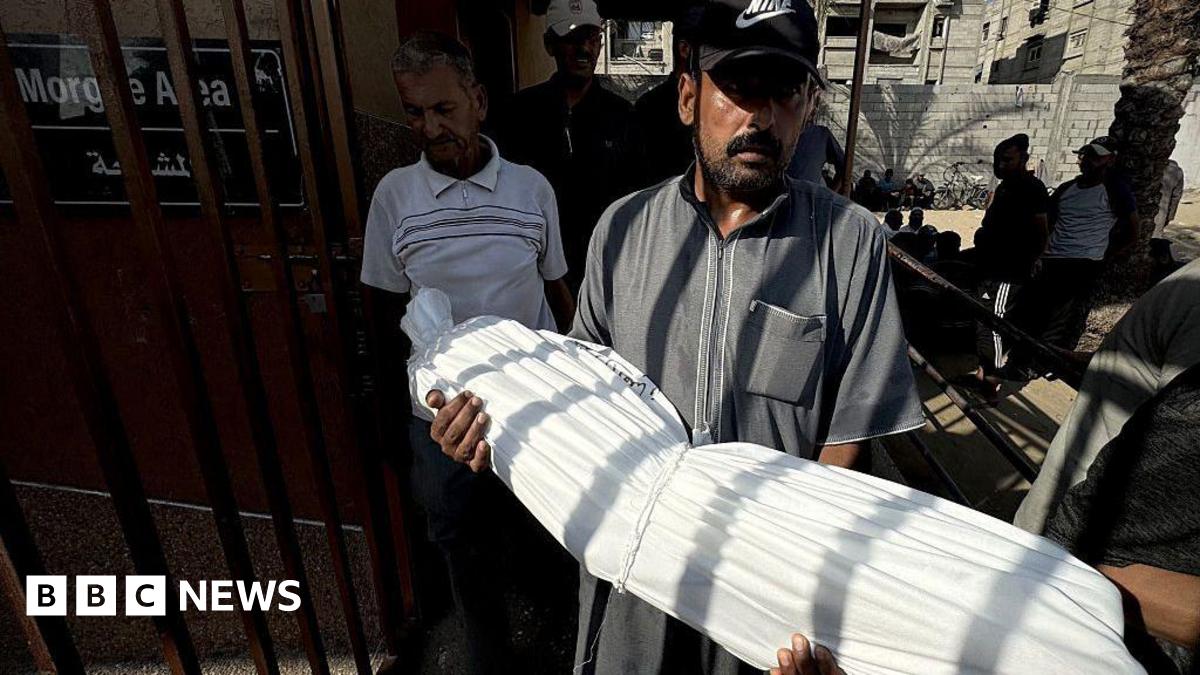International journalists, including the BBC, are blocked by Israel from entering Gaza independently, so it is difficult to verify the number of reported malnutrition deaths.
However, footage filmed by a local Palestinian journalist working for the BBC at al-Aqsa Martyrs hospital in the central city of Deir al-Balah showed the emaciated body of a man called Ahmed al-Hasanat, who doctors said had died from malnutrition on Tuesday.
Health officials said a 13-year-old boy, Abdul Hamid al-Ghalban, also died in the southern city of Khan Younis. Photos from AFP and Anadolu news agencies showed the teenager’s small body being prepared for burial at Nasser hospital and then carried in a white shroud.
Palestinian media meanwhile posted a video showing the body of a six-week-old boy, Yousef al-Safadi, who health officials said died at al-Shifa hospital in Gaza City due to malnutrition.
The US-based medical humanitarian group MedGlobal also said in a statement that its nutritional teams in Gaza had witnessed five severely malnourished children, aged between three months and four years old, die within the past three days.
“This is a deliberate and human-made disaster,” MedGlobal’s executive director, Joseph Belliveau, said. “Those children died because there is not enough food in Gaza and not enough medicines, including IV fluids and therapeutic formula, to revive them.”
MedGlobal said that since the beginning of July, cases of acutely malnourished, mainly children, had nearly tripled at its facilities, indicating a widespread food crisis.
The UN agency for Palestinian refugees (Unrwa) also said that it was receiving “SOS” messages from its staff in Gaza, saying they were desperately short of food.
Some Unrwa doctors and aid workers had reportedly been fainting while working, due to hunger and exhaustion, it added.
Gaza residents also told the BBC that the hunger crisis was the worst in living memory.
Osama Tawfiq, a veteran employee of al-Shifa hospital, said: “I go to work hungry and leave my six children behind, also hungry.”
“There is no food for the patients. Children are dying of hunger inside the hospital. I’ve worked here for 20 years, and never in my life have I seen someone die from starvation until now.”
Mohammed Mahmoud, a father of four, said his family were surviving on tiny amounts of food.
“We haven’t eaten anything except a few lentils in two days,” he said. “We mix a little table salt into a glass of water and drink it, just to get some electrolytes.”
Earlier this week, the World Food Programme (WFP) reported that malnutrition was surging, with 90,000 women and children in urgent need of treatment, and that nearly one person in three was not eating for days.
It noted that food aid was the only way for most people to access any food because prices in local markets had skyrocketed. It said a 1kg (2.2lb) bag of flour now cost over $100 (£74).
The WFP called for a “massive scale-up in food aid distribution” and said it had food supplies nearby and teams on the ground ready to respond.
The UN says a minimum of 600 aid lorries a day need to enter Gaza. However, the UN Organisation for the Co-ordination of Humanitarian Affairs (OCHA) said it was only permitted to bring in 1,600 lorries of aid between May and July – an average of around 27 per day.
On Tuesday evening, Israeli Army Radio quoted Cogat as saying that Hamas was “conducting a false campaign regarding the humanitarian situation in the Gaza Strip, as a pressure tool within the negotiations” for a new ceasefire and hostage deal taking place in Qatar.
Israeli military spokesman Lt Col Nadav Shoshani also posted a video on social media that he said showed 950 lorry loads of aid “currently waiting in Gaza for international organisations to pick up and distribute to Gazan civilians”.
“This is after Israel facilitated the aid entry into Gaza,” he added.
The UN has said that it struggles to pick up and distribute supplies because of the ongoing hostilities, Israeli restrictions on humanitarian movements, and fuel shortages.
